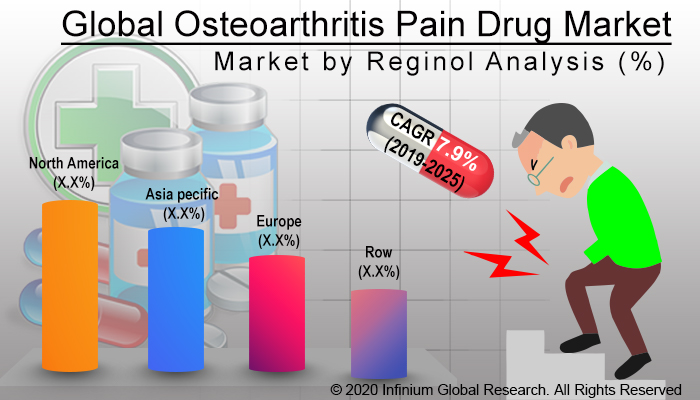Osteoarthritis Pain Drug Market (Drug Class - Corticosteroids, NSAIDS, Viscosupplementation, and Others; Route of Administration - Oral, Parenteral, and Topical; Distribution Channel - Hospital Pharmacies, Retail Pharmacies, and Online Pharmacies): Global Industry Analysis, Trends, Size, Share and Forecasts to 2025
A recent report published by
Infinium Global Research on the osteoarthritis pain drug market provides in-depth
analysis of segments and sub-segments in the global as well as regional
osteoarthritis pain drug market. The study also highlights the impact of
drivers, restraints, and macro indicators on the global and regional
osteoarthritis pain drug market over the short term as well as long term. The
report is a comprehensive presentation of trends, forecast and dollar values of
global osteoarthritis pain drug market. According to the report, the global osteoarthritis
pain drug market is projected to grow at a CAGR of 7.9% over the forecast
period of 2019-2025.
Market Insight
Osteoarthritis, the most common
type of arthritis, is a leading cause of disability. It is a chronic,
progressive degenerative joint disease, which is characterized by the gradual
destruction of the articular cartilage, hypertrophy of the bone margins, a
series of biochemical and morphological changes in the synovial membrane and
joint capsule. Currently, there is no cure to stop osteoarthritis pain but to
reduce using different treatments or therapies. However, osteoarthritis pain
drugs are used to relieve pain. The most commonly used drugs for osteoarthritis
are aspirin, ibuprofen, naproxen, and celecoxib. Medicines for osteoarthritis
pain are available as pills, syrups, creams, lotions and they are injected into
a joint.
Osteoarthritis is growing as a
major public health problem worldwide. The rapidly growing aging population is
the primary factor for the growth in the number of people affected by
osteoarthritis. The prevalence of
osteoarthritis increased by 33% among those aged from 60 to 70 years to 43.7%
among those over 80 years of age. According to the World Health Organization
(WHO) report, Osteoarthritis disease is found more in females rather than males
aged over 60 years. Thereby, increasing the demand for osteoarthritis drugs.
Furthermore, a rise in R&D expenditure and increased geriatric population
are other factors propelling the growth of the osteoarthritis pain drugs market.
Also, increased awareness regarding degenerative bone diseases in developing
countries and a rich pipeline of innovative treatment options are the factors
boosting the osteoarthritis pain drugs market. However, severe side effects
associated with certain injectable treatments remain major restraints to the
market. The treatment options available in the market fail to provide suitable
pain relief in the late stages of osteoarthritis. This led to a larger number
of people opting for natural treatments such as yoga, chiropractic, homeopathy,
and naturopathy, to treat osteoarthritis. Moreover, several pharmaceutical
companies are focusing on the new formulation of the drug for the treatment of
osteoarthritis. Many clinical trials and
researches are being performed in different phases and new drugs are expected
to be launched in the market. This is anticipated to generate favorable
opportunities for several manufacturers in the osteoarthritis pain drugs
market.
Geographically, North America
holds the dominant share in the osteoarthritis pain market. The availability of
better treatment options, high awareness among people, government reimbursement
policies is major factor driving the osteoarthritis pain drug market in North
America. Osteoarthritis is the most common joint disorder in the United States
and affects over 30 million US adults. The Asia Pacific region holds the second
largest market share in the osteoarthritis pain drug market. The Asia Pacific
(APAC) region is aging more rapidly than any region. In addition, the old-age
support ratio in China is projected to plummet from 7.9 to 2.4 by 2050 that in
turn will facilitate demand for osteoarthritis drugs in the Asia Pacific
region. Furthermore, Japan is the second-largest market for viscosupplementation
products after the U.S. which in turn is anticipated to further boost the
market in the Asia Pacific in the near future.

Segment Covered
The report on global
osteoarthritis pain drug market covers segments such as drug class, route of
administration, and distribution channel. On the basis of drug class, the
sub-markets include corticosteroids, NSAIDS, viscosupplementation, and others.
On the basis of the route of administration, the sub-markets include oral,
parenteral, and topical. On the basis of the distribution channel, the sub-markets
include hospital pharmacies, retail pharmacies, and online pharmacies.
Companies Profiled:
The report provides profiles of
the companies in the market such as Horizon Pharma plc, Pfizer Inc, Sanofi
S.A., Anika Therapeutics, Inc., Ferring B.V., Bioventus, Inc., Chugai
Pharmaceutical Co., Limited, Alkem Laboratories, Flexion Therapeutics, Inc.,
and Zimmer Biomet Holdings, Inc.
